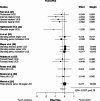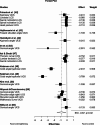Effects of Stretching or Strengthening Exercise on Spinal and Lumbopelvic Posture: A Systematic Review with Meta-Analysis
- PMID: 38834878
- PMCID: PMC11150224
- DOI: 10.1186/s40798-024-00733-5
Effects of Stretching or Strengthening Exercise on Spinal and Lumbopelvic Posture: A Systematic Review with Meta-Analysis
Abstract
Background: Abnormal posture (e.g. loss of lordosis) has been associated with the occurrence of musculoskeletal pain. Stretching tight muscles while strengthening the antagonists represents the most common method to treat the assumed muscle imbalance. However, despite its high popularity, there is no quantitative synthesis of the available evidence examining the effectiveness of the stretch-and-strengthen approach.
Methods: A systematic review with meta-analysis was conducted, searching PubMed, Web of Science and Google Scholar. We included controlled clinical trials investigating the effects of stretching or strengthening on spinal and lumbopelvic posture (e.g., pelvic tilt, lumbar lordosis, thoracic kyphosis, head tilt) in healthy individuals. Effect sizes were pooled using robust variance estimation. To rate the certainty about the evidence, the GRADE approach was applied.
Results: A total of 23 studies with 969 participants were identified. Neither acute (d = 0.01, p = 0.97) nor chronic stretching (d=-0.19, p = 0.16) had an impact on posture. Chronic strengthening was associated with large improvements (d=-0.83, p = 0.01), but no study examined acute effects. Strengthening was superior (d = 0.81, p = 0.004) to stretching. Sub-analyses found strengthening to be effective in the thoracic and cervical spine (d=-1.04, p = 0.005) but not in the lumbar and lumbopelvic region (d=-0.23, p = 0.25). Stretching was ineffective in all locations (p > 0.05).
Conclusion: Moderate-certainty evidence does not support the use of stretching as a treatment of muscle imbalance. In contrast, therapists should focus on strengthening programs targeting weakened muscles.
Keywords: Back pain; Forward Shoulder; Forward head Posture; Kyphosis; Lordosis; Muscular Imbalance; Pelvic tilt; Strengthening; Stretching.
© 2024. The Author(s).
Conflict of interest statement
The authors declare that they have no competing interests.
Figures



Similar articles
-
Relationships between forward head posture and lumbopelvic sagittal alignment in older adults with chronic low back pain.J Bodyw Mov Ther. 2021 Oct;28:150-156. doi: 10.1016/j.jbmt.2021.07.036. Epub 2021 Aug 8. J Bodyw Mov Ther. 2021. PMID: 34776134
-
Measurements of lumbopelvic lordosis using the pelvic radius technique as it correlates with sagittal spinal balance and sacral translation.Spine J. 2002 Nov-Dec;2(6):421-9. doi: 10.1016/s1529-9430(02)00426-6. Spine J. 2002. PMID: 14589266
-
Comparison of Pelvic Tilt Before and After Hip Flexor Stretching in Healthy Adults.J Manipulative Physiol Ther. 2021 May;44(4):289-294. doi: 10.1016/j.jmpt.2020.09.006. J Manipulative Physiol Ther. 2021. PMID: 34090549
-
Effects of exercise programs on kyphosis and lordosis angle: A systematic review and meta-analysis.PLoS One. 2019 Apr 29;14(4):e0216180. doi: 10.1371/journal.pone.0216180. eCollection 2019. PLoS One. 2019. PMID: 31034509 Free PMC article.
-
The effect of various therapeutic exercises on forward head posture, rounded shoulder, and hyperkyphosis among people with upper crossed syndrome: a systematic review and meta-analysis.BMC Musculoskelet Disord. 2024 Feb 1;25(1):105. doi: 10.1186/s12891-024-07224-4. BMC Musculoskelet Disord. 2024. PMID: 38302926 Free PMC article.
Cited by
-
Effects of combined jaw and cervicoscapular exercises on mouth opening and muscle properties in cervical extension type.Sci Rep. 2025 May 30;15(1):19049. doi: 10.1038/s41598-025-03846-3. Sci Rep. 2025. PMID: 40447683 Free PMC article. Clinical Trial.
-
Practical recommendations on stretching exercise: A Delphi consensus statement of international research experts.J Sport Health Sci. 2025 Jun 11;14:101067. doi: 10.1016/j.jshs.2025.101067. Online ahead of print. J Sport Health Sci. 2025. PMID: 40513717 Free PMC article.
-
Effect of an 11-Week Repeated Maximal Lumbar Movement with Controlled Breathing on Lumbar Sagittal Range of Motion in Elite Swimmers: A Randomized Clinical Trial.Healthcare (Basel). 2025 Feb 20;13(5):457. doi: 10.3390/healthcare13050457. Healthcare (Basel). 2025. PMID: 40077019 Free PMC article.
-
Isometric or Isotonic Exercises in Alleviating Chronic Neck and Shoulder Pain and Enhancing Quality of Life Among Computer Users with Upper Crossed Syndrome: A Randomized Controlled Trial.Anesth Pain Med. 2025 May 13;15(3):e160771. doi: 10.5812/aapm-160771. eCollection 2025 Jun 30. Anesth Pain Med. 2025. PMID: 40727637 Free PMC article.
References
-
- Jones P. An Essay on Crookedness, or Distortions of the Spine. 1788.
-
- Sadler SG, Spink MJ, Ho A, De Jonge XJ, Chuter VH. Restriction in lateral bending range of motion, lumbar lordosis, and hamstring flexibility predicts the development of low back pain: a systematic review of prospective cohort studies. BMC Musculoskelet Disord. 2017;18:179. doi: 10.1186/s12891-017-1534-0. - DOI - PMC - PubMed
Publication types
LinkOut - more resources
Full Text Sources

